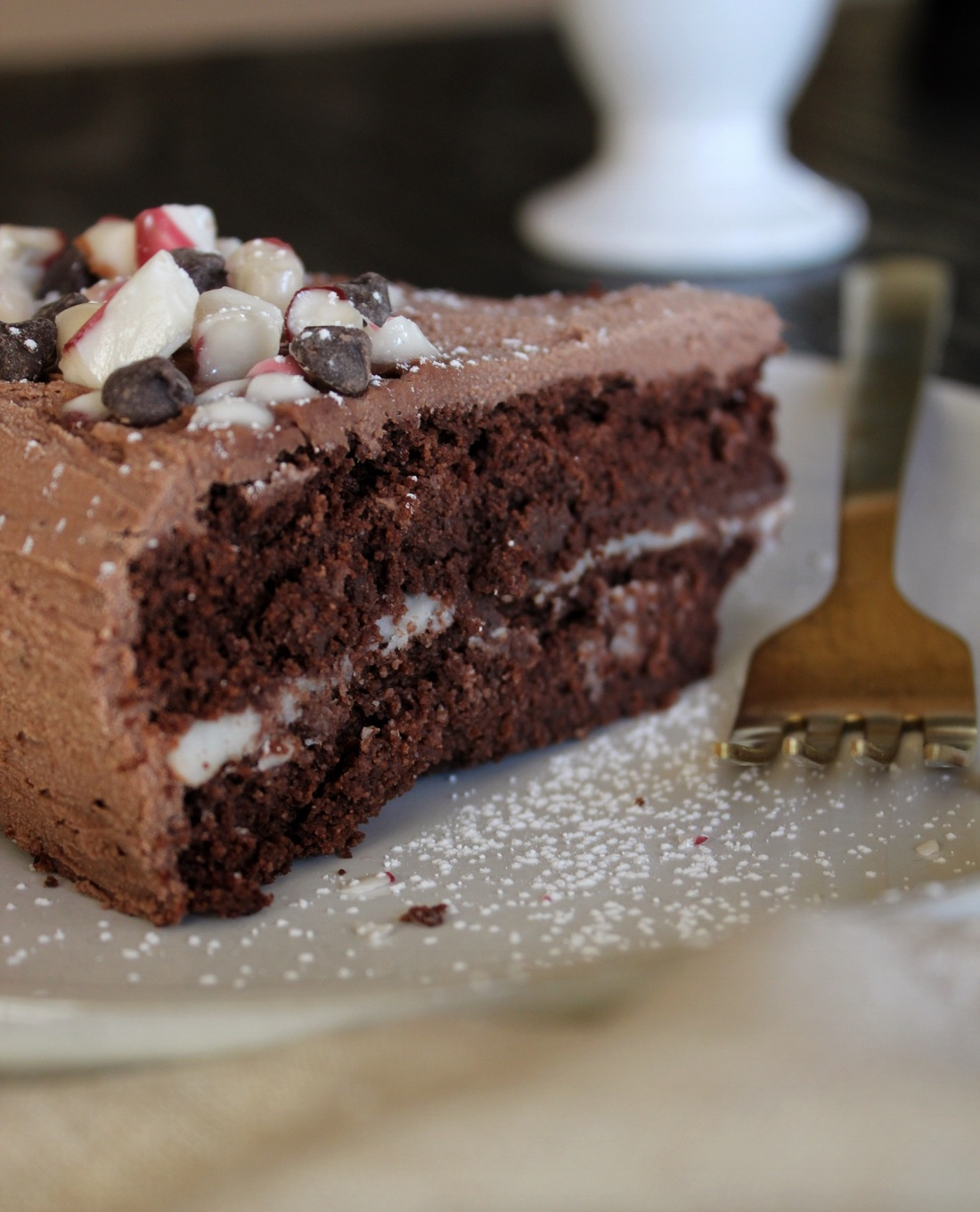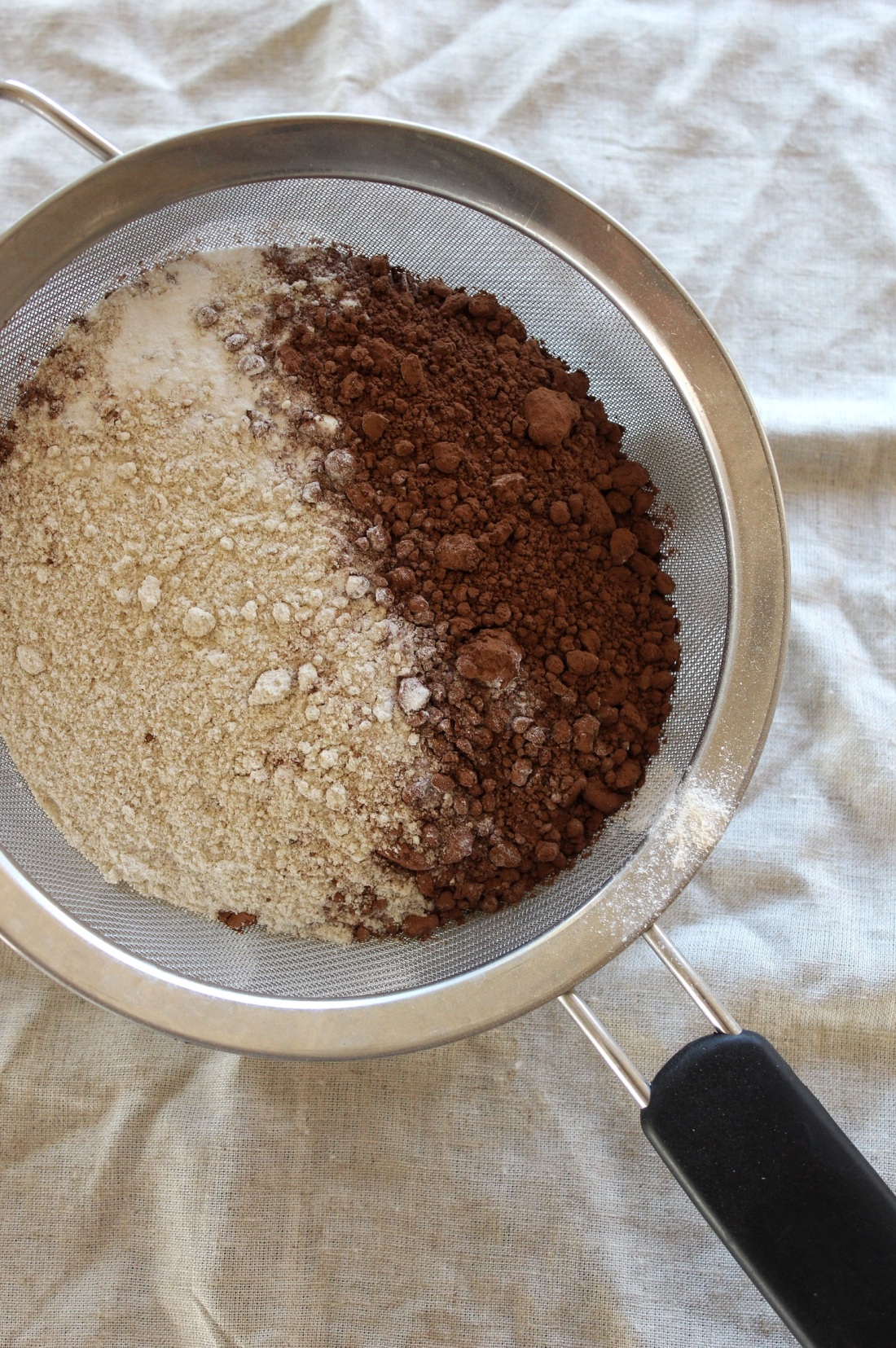 Experimenting with our cornless cake recipe led us to discover that “Hey! Yeah, I’m talking to me. Maybe making a light, moist, fluffy, and sweet cake isn’t impossible without sugar, wheat, and all the things that make most cakes light, moist, fluffy, and sweet.”
Experimenting with our cornless cake recipe led us to discover that “Hey! Yeah, I’m talking to me. Maybe making a light, moist, fluffy, and sweet cake isn’t impossible without sugar, wheat, and all the things that make most cakes light, moist, fluffy, and sweet.”
The process starts by beating together solid coconut oil with erythritol, the crystals in which poke little holes into the fat thus incorporating air into the mixture. From there, the “eggs” (i.e. flax meal mixed with water) are beaten in until smooth. Then, sifted dry ingredients and wet ingredients are added in alternating batches until everything comes together. Finally, the key to creating an incredibly light cake is folded in: aquafaba.
This whole process is known as the creaming method and it’s essential in baking for making cakes, cookies, cupcakes, and the likes. The reason this cake works – even without sugar, butter, dairy, eggs, or wheat flour – is because it’s not necessarily the ingredients that are important, it’s what the ingredients are comprised of that’s important.
Sugar is comprised of crystals. Wheat flour is comprised of starch and some protein. Butter is comprised 80% fat and 20% water. Eggs are comprised of roughly 45% protein and 55% fat. Dairy is comprised of water and a small amount of fat and protein.


With the “alternative baking world” advancing, smart people out there have discovered that aquafaba can be whipped into a foam, like egg whites. They found out that certain compounds in fruits and trees can be converted into sugar alcohols (such as erythritol & xylitol), which are processed into crystals, like sugar. They found out that the fat content of flax seeds are similar to that of egg yolks, so it can be used similarly.
When you break it down, alternative baking is the same as conventional baking, only more test trials are required to find out the right ratios because people haven’t been practicing with these ingredients for hundreds of years.

As for frosting, we wanted something sticky to hold the two layers of cake together, thus we went for a base of coconut butter, which functions like glue for these two layers. For the top and edges of the cake, however, we wanted something fluffy and soft but not runny, thus we went with a base mixture of coconut cream, which is fluffy, and coconut butter, which helps stabilize the frosting.
With a grand appearance, indulgent flavors, and mouth appeasing textures, this cake is sure to knock the socks off of yourself and your guests, making them doubt your honesty when you tell them it’s free from sugar, dairy, wheat, etc, etc, etc…
Basically, anyone can eat it!

We hope you you enjoy this chocolate cake as much as we do! If you like what your taste buds are tellin’ ya, leave behind a nice rating, share your thoughts with us in the comments, or show us your creations by tagging @noeggsorham on Instagram.
Before you go, we’d like to know what dishes you want to see us create! Let us know by submitting your favorite childhood dish on this page and we’ll do our best to recreate it.
Cheers!
Ryan & Kim

Chocolate Cake with Coconut Mint Frosting (sugar-free, lectin-free, & vegan)
Light & moist chocolate cake with creamy, peppermint frosting.
Ingredients
Cake
- 96 g (3/4 c) cassava flour
- 204 g (1 1/2 c) sorghum flour + more for coating
- 40 g (1/2 c) cocoa powder
- 1 1/2 tsp baking powder
- 1/2 tsp baking soda
- 3/4 tsp salt
- 3 flax eggs (3 tbsp flax meal + 1/2 c water)
- 4 oz (1/2 c) aquafaba (liquid from can of chickpeas)*
- 84 g (1/4 c + 2 tbsp) solid coconut oil + more for coating*
- 72 g (1/4 c + 2 tbsp) erythritol
- 6 oz (3/4 c) coconut milk
- 1 tbsp vanilla extract
- 1 tsp apple cider vinegar
- 1/2 tsp liquid stevia extract
Frosting #1 (Inner-Frosting)
- 1/4 c + 2 tbsp coconut butter
- 1/2 tsp vanilla
- 10 drops liquid stevia (about 1/8 tsp)
Frosting #2 (Outer-Frosting)
- 1 can of full-fat coconut milk, refrigerated overnight*
- 56 g (1/4 c) coconut butter
- 24 g (2 tbsp) erythritol
- 1 tsp vanilla
- 1/2 tsp peppermint extract
- 1/4 tsp stevia
- Small pinch of salt
Directions
- Pre-heat oven to 375° F. Lightly coat sides & bottom of a round, 9 inch cake pan with coconut oil. Then, toss about 2 tablespoons of sorghum flour around in pan to coat the coconut oil. Shake out the excess flour and set prepped pan to the side.
- Sift together cassava flour, sorghum flour, cocoa powder, baking powder, baking soda, and salt into a medium-sized mixing bowl. In a separate bowl, whisk together coconut milk, vanilla extract, and stevia. Set both aside.
- In the bowl of your stand up mixer fitted with the whisk attachment or in a large bowl with an electric hand-whisk, beat aquafaba on high until stiff peaks are formed; 6-9 minutes. Because it does splatter, I like to set a tea towel over my mixer while it whisks.
- Transfer aquafaba to a separate bowl, cover with plastic wrap, and place in fridge until ready to use.
- Rinse out bowl of stand-up mixer and add solid coconut oil and erythritol. Beat at medium speed with the paddle attachment until erythritol is no longer visible and the oil is fluffy; about 2 minutes.
- Scrape down the sides with a spatula then beat in flax eggs at medium speed until incorporated.
- Slowly add in 1/3 of the dry mixture and beat until smooth. Then, add in 1/3 of the wet ingredients and beat until smooth. Repeat until all of the ingredients are incorporated.
- Remove bowl from mixer, add in half of the whipped aquafaba, and stir vigorously until it’s no longer visible. Then, gently fold in the second half with a spatula – if some pecks of white remain this time, it’s okay.
- Transfer batter to prepped cake pan,and set in the center of your oven for 28 – 35 minutes, or until a toothpick inserted into the middle comes out mostly clean, with some specks of chocolate on it.
- Remove from oven and cool in cake pan for 20 minutes. Then, flip out onto a plate or cooling rack and let rest until completely cool; about 1 hour & 15 minutes.
- While cake cools, prepare Frosting #1 by combining all of the ingredients in the bowl of your stand up mixer (or hand-held mixer) and beating with the paddle attachment until smooth. Transfer to a small bowl, cover with plastic wrap, and set aside.
- For Frosting #2, open can of refrigerated coconut milk and scoop off the solid cream from the top into a personal-sized blender or mini-food processor.
- Then, add 2 tbsp of the liquid remaining in the can to the blender/food-processor, along with all other ingredients, and blend until completely smooth.
- Transfer to a shallow bowl and set in fridge while the cake cools. Monitor the frosting as it cools, because if it chills too much it will become hard to spread. About one hour to an hour & a half should do the trick; the frosting should be soft & spreadable, but not runny.
- When the cake is completely cooled, transfer to a plate or cookie sheet – the edges of which will help guide you through cutting the cake in half.
- Using a long bread knife, carefully saw through the cake. I like to saw through in one direction, spin the plate a few degrees, saw in another direction, spin again, and repeat until it’s cut clean in half.
- Carefully slide the top half onto a separate cookie sheet or plate. Flip the bottom half onto a cake stand (or plate) to be frosted. The cooked side should be facing up now. With a spatula, evenly spread Frosting #1 (the inner-frosting) on top of the bottom half – not on the sides.
- Carefully slide the top half onto the bottom half and evenly spread Frosting #2 all over the cake. I find it easiest to place all of the frosting on top at once, then spread it out to the sides from there.
- Cut into as many slices as you’d like and enjoy! Store at room temperature – covered with a lid or plastic wrap – for up to 4 days.
*Use the liquid from a can of Eden’s Chickpeas, which are pressure-cooked, to ensure they’re free from lectins.
*To ensure coconut oil stays solid while mixing, I like to place it in the fridge for 15 minutes prior to mixing.
*For optimal separation of cream from liquid, I find that 365’s Organic Coconut Milk works really well here.
*For less steps and an overall easier cake, you can skip out on cutting it in half and making frosting #1, as cutting the cake in half can be tedious. For this variation, let the cake rest until cool then spread on frosting #2. It won’t be as grand looking, but it will still be delightful.

Recently, I have been taking some of Dr. Gundry supplements, reading and re reading The Plant Paradox so that I can share it with my chef (my husband) and looking forward to getting well, but the thought of not having the foods that I love, while eating less animal products was getting me down. Finding your website nohamoreggs with all these good-sounding, lectin free or low-lectins recipes is a big encouragement to me right now. As a thank you, I want to share a little trick I use in cutting baked goods.
I use a heavy duty sewing thread, cut a long piece, firmly wrap an around each index finger and line up with the baked good. Then I slice through it pulling one side and then the other until I slice through to the other side. It is much faster and more accurate than cutting the baked product with a knife.
LikeLike
* Sorry, in the second paragraph it should read, “firmly wrap an ‘end’ around each index finger”.
LikeLike
Hey Joan!
I apologize for the late response, but that’s a great tip! I’ve heard of bakers using tooth floss to cut through pastry dough, but never sewing thread, which I imagine works similarly but with more strength.
We’re also ecstatic to hear that our recipes are helping you along your lectin-limited journey. When I first started, I ate very few of the foods I craved. However, I found that over time you start to find ways to make the foods you want coherent with your diet, which is way more fun than being able to have whatever you want when you want it (in my opinion).
Best,
Ryan
LikeLike
Wow, this looks terrific! I will have to try it. This is an idea I am trying to spread this holiday season. https://www.youtube.com/watch?v=Hidlnk1NC10 If you like it, please share it. Thanks, Rita
LikeLike
Yum!! Chocolate and mint together is my favourite! (:
LikeLike